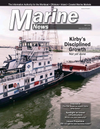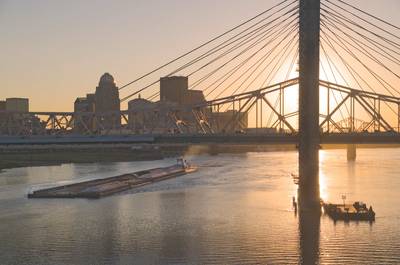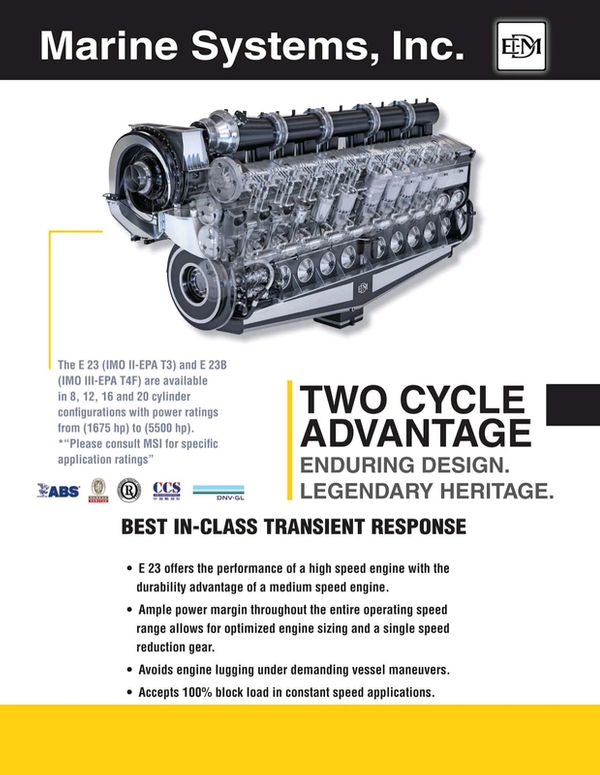
Interview: Mark Knoy, President and CEO, ACBL
American Commercial Barge Line (ACBL) named Mark K. Knoy as its president and chief executive officer in August 2011. Prior to joining ACBL, he was vice president of American Electric Power’s (AEP) Fuel, Emissions and Logistics Group and president of AEP River Operations, having joined AEP with its 2001 purchase of MEMCO Barge Line. From 1984 to 1994, he was owner/operator of The Mark Twain Towing Company and Delmar Marine, Inc., Pekin, Illinois. He began his career in 1973 working aboard towboats on the inland waterways as a deck hand and then as a captain. Today, Knoy serves as a director of the Corps of Engineer’s Inland Waterways Users Board, a Board of Trustees’ member for both the Coast Guard Foundation and The Seamen’s Church Institute and its Center for Maritime Education and Ministry on the River, chairman of the National Waterways Foundation, and board member for the H.T. Pott Inland Waterways Library at the University of Missouri - St. Louis. He is a past chairman of both the Waterways Council, Inc. and the Midwest Region of the American Waterways Operators. Quite simply, there is perhaps no better known name, with more impressive credentials, on the inland waterfront. This month, he weighs in for Marine News readers on a wide range of issues impacting the commercial, inland waterfront.
Give us your assessment of today’s market conditions on U.S. inland waters, especially in the areas that ACBL operates.
Stating the more obvious, there are too many barges in both the dry and liquid markets, creating cheap freight prices. For dry commodities, the biggest culprit is coal. At its peak in 2006, barges delivered more than 160 million tons of coal to utilities. In 2017, early estimates suggest that number was barely 90 million tons. We have increased competition from South America in the Agricultural sector, with Brazil and Argentina now both major players in the global market. There’s a lot going on with the steel and aluminum tariffs on imports, but it isn’t yet clear how that will shake out in the end, but I believe it will be good for our industry in two ways. One, barge prices are increasing with higher steel prices and will need higher revenues to justify investment. Secondly, we should handle more steel inputs with less semi-finished imports.
Another bright spot is the construction industry, which accounted for more than 40 percent of steel shipments in 2016 as well as construction materials. It looks like it might be about to turn the corner and finally show some solid recovery following the recession. We also expect to see some benefit from promised infrastructure development – not only in terms of waterways infrastructure but in demand for the commodities needed to bring it to fruition.
Demand for liquid barges surged in the middle of the last decade when the country experienced massive growth in crude oil production and relied heavily on rail and barge to deliver their product. That demand slowed as more pipeline capacity became available. There is, however, a great deal of construction activity going on, particularly along the Gulf Coast, to support growth in the refining and chemicals industries. Inexpensive and abundant supplies of natural gas and crude oil have enticed companies from all over the world to invest in U.S.-based petrochemical production. The American Chemistry Council estimates that there are more than 300 projects representing capital investment of $185 billion in various stages of development due to shale gas. U.S. crude oil production is increasing at a remarkable pace and is expected to exceed average production of 11 million barrels per day in 2018. Finally, over the last five years, exports of U.S.-made ethanol have more than doubled to total 1.3 billion gallons in 2017. All these developments will lead to exciting opportunities in our liquids business.
What will it take for freight rates to improve on the inland rivers?
Simply put, more demand or less supply. Higher steel prices create higher scrap prices and that could drive some barges into retirement early basis the scrap revenue against the current market freight earnings. Secondly, the current freight market will not support hopper barges that will soon exceed $600,000 to build. I would expect tank barge prices to move up sharply as well and that should curtail investor building as these new construction prices aren’t supported by today’s revenues.
You are unique among your inland CEO peers in that you’ve worked on deck and as a Captain, prior to stepping into the boardroom. What do you bring from the wheelhouse to the c-suite that helps you run a better company?
It really is apples and oranges in working on a boat versus leading a company, but we’re still in the same family, and that’s people. Leading people is the secret to any team’s success and I love the challenge and opportunity that this team gives me every day. I certainly have a firsthand understanding of the risk that we are asking our mariners to manage. My towboat experience gave me a greater appreciation of the commitment and sacrifice that mariners make daily to keep freight moving along our waterways. Therefore, I’m very passionate about the safety and wellness of our mariners and their families. I always strongly encourage our new teammates to get out on a boat, to a fleet, dock, terminal or shipyard and see how these pieces fit together to deliver to the building blocks of our nation, distribution energy resources and moving agricultural products to export in the most efficient and safest mode there is.
Do you see more consolidation ahead, as operators struggle to get the rates they need to keep quality equipment and mariners on the water?
We are all struggling in these challenging markets with surplus equipment. Nobody sets their sights on selling at the bottom, so I think we’ll have to see some upswing before consolidation comes back into play. The industry is fairly well consolidated already. On the dry cargo side, there are only six operators with 90 percent of the equipment; and eight tanker barge operators handle 77 percent of all tankers.
Your 2017 sale of some ACBL tonnage and assets came an interesting time. On one hand, coal has made a bit of a rebound (some would say temporary). What was behind the transaction and what’s next for your firm?
Utility demand for barged coal has declined by roughly 70 million tons since its peak. Utilities are not building new coal plants because they do not believe one or two administrations will significantly alter the environmental trends or cost differentials that have been driving them away from coal for the past several years. It is simply not worth the risk to invest in an expensive plant that probably won’t be cost-effective to operate. It is true that coal exports have seen a rebound over the past couple of years, but they are still well below their peak of more than 125 million tons in 2012. It is important to understand that the U.S. is a swing supplier to the global market. Countries typically only “shop” the U.S. for coal when they must because of higher shipping costs due to relative the length of the ocean voyage. Also because of shipping distances, East Coast ports are generally preferred to the Gulf Coast. If/when coal exports decline, the first to feel it will be the Gulf Coast and the barge industry.
The ACBL fleet of more than 3,600 barges and 140 towboats, coupled with your network of logistics hubs and transshipment facilities brings together a multimodal, flexible supply chain for customers. Tell us about the value that this brings.
Anytime we can differentiate ourselves from our competitors, we have an edge and that’s what we’re constantly looking for. In Memphis, we can offer liquid customers delivery from barge, through our terminal and directly to their local plant, one stop shopping. In St. Louis, we transfer western coal to barges for final delivery to their generating station. We handle all of their logistics and help with surging inventories. Have a high-speed unit-train transfer facility below the last locks keeps us operational year round. Lastly, in Lemont, we offer break-bulk handling of steel materials from barge to warehouse to truck to final delivery. In each of these cases, we make it easy for our customers to manage their transportation logistics with one contact and one final invoice.
In 2015, AEP River Operations was sold by its parent company to ACBL. Talk about the integration and what’s happened in the interim.
There was a tremendous amount of synergies in the business, and great number of talented mariners, and teammates with relationships throughout the industry. Overall, the integration went extremely well from our perspective and we continued to crank out efficiencies in the operations for a couple years. I think we’re now operating with the most efficient model. There were many similarities between the cultures, but change is always challenging no matter how similar goals and objectives may be. Managing the change through this process is the most difficult, and the most rewarding.
Transporting agricultural products to deep draft export venues is one of the most important functions of domestic inland rivers. Competitors from South America are trying to do the same thing. Are we doing enough to maintain our inland infrastructure, locks and dams?
Having the Inland Waterway System we have in our country benefits not only the farmer, by being more competitive in a world market, but also benefits our coal exports, and our manufacturing, that relies on our Inland Waterways for the efficient movement of raw materials needed for production of products that consumers purchase on a daily basis. While other countries are improving their delivery systems, Congress seems to be satisfied with just barely maintaining our Inland Waterways. In comparison to many other programs, the inland waterways system could be brought up to world class standards of less than $10 billion. That seems like a bargain when compared to other infrastructure challenges.
The federal FY18 Omnibus includes $6.83 billion for the U.S. Army Corps of Engineers (Corps), an increase of $789 million from fiscal 2017. The President speaks of so-called P3 projects for infrastructure. What are your thoughts on that score?
Public Private Partnerships on other modes of transportation may work, however on the Inland Waterways we have had a Public Private Partnership since the Inland Waterways Revenue Act was codified in 1978. Since this legislation was enacted the Inland Waterways Industry, via the Inland Waterways Trust Fund (IWTF) have contributed $2.8 billion into rebuilding our Inland Waterways Infrastructure while the U.S. Treasury has contributed $3.7 billion into our infrastructure. So how does adding additional P3’s that could impose additional tolls, lockage fees, or vessel fees, make our countries exports more competitive in the world economic environment?
Jeffboat, one of the nation’s oldest, largest and best-known inland builders will close its doors, owing largely to an extremely quiet barge-building sector. That said; certain sectors of our barge fleets are quite mature, while others very new. What’s the time sequence that you would see for any uptick in the barge newbuild sector, and what will eventually precipitate that movement?
One the dry side, we anticipate it will take through at least 2019 before attrition brings the size of the fleet more in line with demand. Significant demand growth would, of course, speed up the process. The pressure index on tank barges is well into the negative with significant new builds over the past several years that were not supported by increasing demand. Most of the new builds were unit tow barges. It looks like the fleet has somewhere around 500 too many barges for current demand levels.
Subchapter M is here and it is impacting the inland waterfront like nothing that came before it. Will SubM be largely a ‘non-event’ for your tonnage and mariners or will there be certain things that you’ll need to do different?
ACBL is certainly ready for the implementation of SubM, as should other AWO members that have been following these new regulations. It certainly will not go without notice here at ACBL, as the volume of paperwork itself is staggering. Excluding the paperwork, I do think the new regulations will separate our industry into compliant and non-compliant operators and it will be up to the USCG to enforce the new rules. Even without enforcement, we will all be better operators, but it will cost some operators additional dollars if they have not been living and breathing the AWO RCP or another SMS.
Inland operators depend heavily on the maintenance of inland waterways. Many stakeholders agree that this is not keeping pace with failing infrastructure that is well past its intended life span. Your past role with WCI positions you well to speak about solutions. What are your thoughts?
In 2015 the Corps received ~$649 million in O&M funding for Inland Waterways, the Omnibus legislation that just passed funds Inland Waterways O&M at $992 million, ~35 percent increase in O&M for Inland Waterways, so it would seem we are getting our message to our Federal Appropriators on the importance of increasing O&M funding for our Inland Waterways.
Regarding inland infrastructure, so much depends on it – your business as well as the supply chain itself. What would be the consequences of a major lock failure on our primary tributaries?
Over the last six months, ACBL has lost nearly $10 million due to the closures at Lock 52. Reference the most recent joint study between the National Waterways Foundation and the U. S. Maritime Administration, compiled by the Vanderbilt University and the University of Tennessee, which found a catastrophic failure of an important lock failure, on our primary tributaries, would result in ~$1.1 billion and ~$1.7 billion in annual transportation costs.
Does coal have a future?
Coal absolutely has a future. There are still many highly efficient, low emission coal-fired power plants producing electricity. These plants have long lifespans and will continue to supply the grid for many years to come. The lion’s share of domestic coal consumption (93 percent in 2017) is for electrical power generation. That being said, domestic utility coal is not a growth market. No new coal-fired power plants are under construction or even on the drawing board. The Department of Energy projects coal consumption by the electric power sector to fall from 675 million tons in 2017 to a low of 595 million tons by 2022. Although they do predict a rebound from those lows, they don’t expect coal consumption by the electric power sector to surpass 641 million tons through their forecast out to 2050. In terms of exports, the Department of Energy projects incremental increases in coal exports but not exceeding 100 million total tons through 2050. The small growth in exports is just not enough to offset the downturn in domestic consumption. Over the last two decades, Utility coal moved on waterways dropped 54 million tons while the barge fleet only shrunk by 1,342 barges, or about half of what the historical coal to barge ratio was.
What keeps you up at night when it comes to operating your considerable assets?
The health and wellness of our teammates, the majority of who work in high-risk areas.
 (Photo: ACBL)
(Photo: ACBL)
(As published in the May 2018 edition of Marine News)
Read Interview: Mark Knoy, President and CEO, ACBL in Pdf, Flash or Html5 edition of May 2019 Marine News
Other stories from May 2019 issue
Content
- Interview: Mark Knoy, President and CEO, ACBL page: 14
- INSIGHTS: Dennis Wilmsmeyer, Executive Director, America's Central Port page: 16
- OP/ED: Is Short Sea shipping on the horizon along the Atlantic Intracoastal Waterway? page: 24
- Risk Management on the Inland Waterways Evolves page: 26
- SAFETY: Distractions Can Sink Careers page: 30
- Staying Afloat with Strong Workboat Insurance page: 32
- INLAND FINANCE: But I Don’t Need That Much page: 32
- Kirby’s Secret Sauce page: 40
- Energy Storage Life Cycle Cost Study page: 44
- TECH FILE: Gas Freeing Barges the Modern Way page: 49


